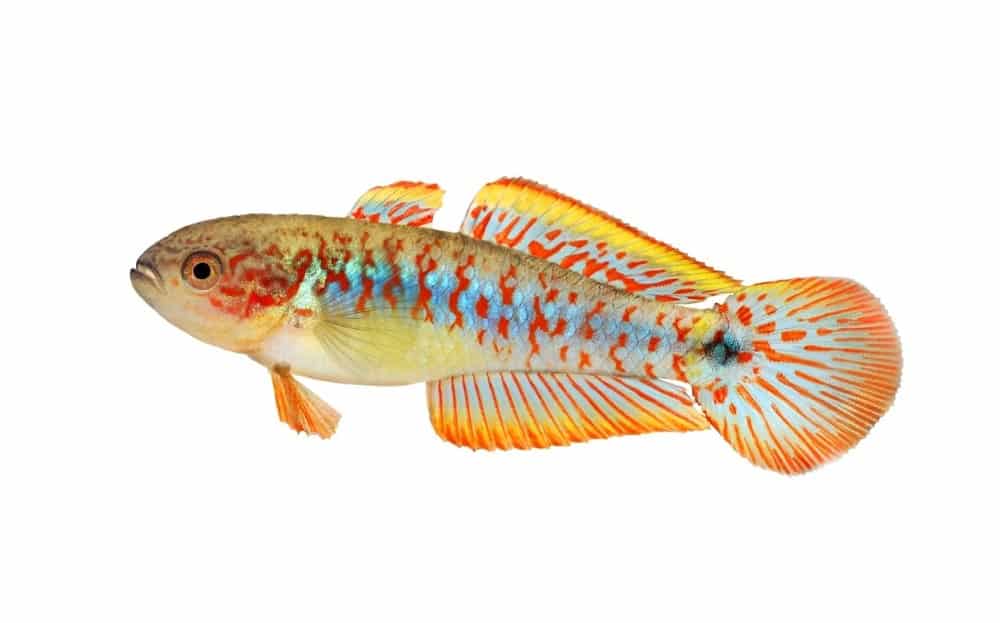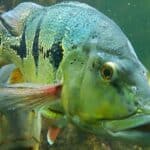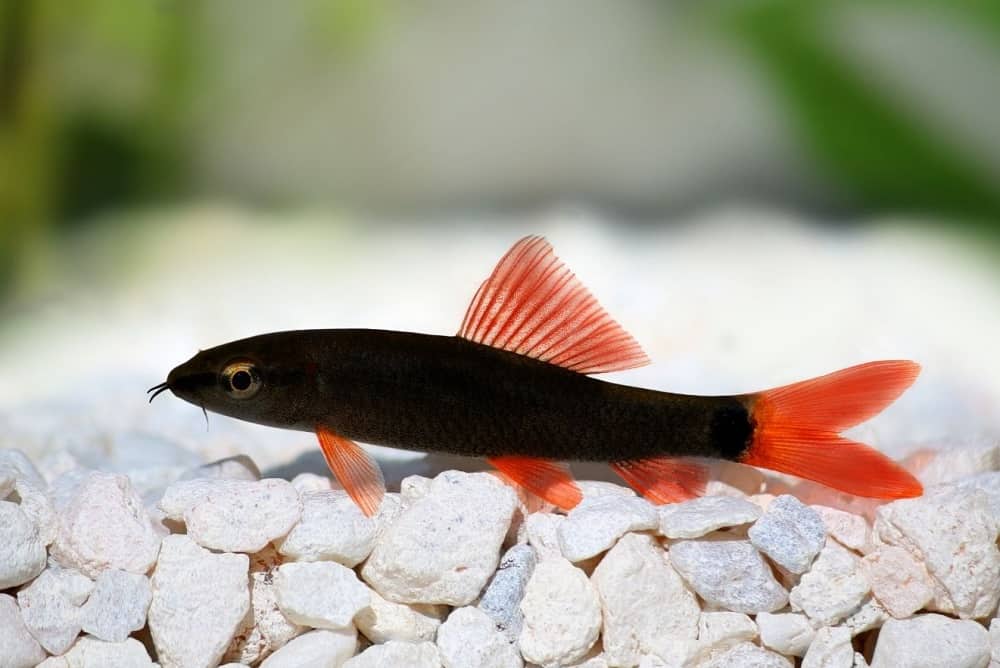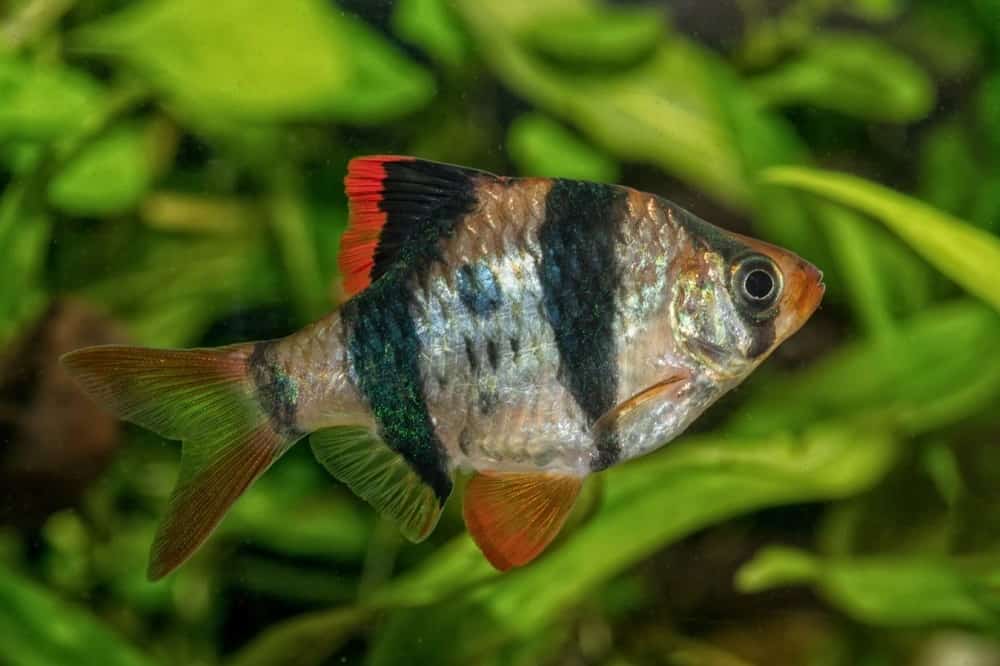Peacock Gudgeons are attractive fish with very fun personalities. Apart from being fussy with their food, they are easy to care for and make peaceful members of domestic aquariums.
They are known for their peaceful and easy-going temperament, so finding tank mates for these little fish is quite easy. They like to live in groups, so you can get several of these beautiful fish to brighten up your tank.

If you’re still unsure if Peacock Gudgeons are the right fish for you, or you want to find out more about how to care for them, keep reading! We will take you through their ideal tank conditions, their diet, behavioural traits and much more.
Species Summary
This fish shares its beautiful appearance with the colorful birds they are named after. They originate in Oceania, preferring shallow water. They can be found in the streams and ponds of New Zealand, Australia and Papa New Guinea. You will need to ensure you have a secure lid on your tank as these fish are gifted jumpers!
Care Guide
Tank Size
Peacock Gudgeons do not require a great deal of swimming space. 15 gallons is an ideal amount for a school of 6 Peacock Gudgeons. You will require more space if you plan on mixing species or you have more than 6 fish. .
Tank Mates
Peacock Gudgeons will do well with any fish that match their peaceful nature. They are small and will not defend themselves so avoid putting them with aggressive fish. Some larger fish may even be able to swallow a Peacock Gudgeon whole.
If you intend to place territorial fish in the same tank as Peacock Gudgeons, make sure your tank is large enough for the fish to have their own territories without getting in each other’s way.
Try introducing Cory Catfish, Cherry Barb, or Bumblebee Goby into your aquarium community.
Same Species Tanks
Peacock Gudgeons prefer being in a school of 6-8 of their own species rather than on their own. If you intend on introducing fewer Peacock Gudgeons into an already established tank of multiple species, make sure you have at least 6-8 fish in the tank in total or the Peacock Gudgeons could get lonely and stressed.
Water Parameters
These freshwater fish come from a natural habitat of slow moving water in warm ponds and gentle streams. They are not the strongest swimmers and If the water flow in your tank is too strong, this will make them stressed and unhappy.
If your water filter creates a current that is too strong, try facing it towards the glass of the tank or placing a plant or decoration in front of it.
The water temperature will need to remain within 72 to 79 degrees fahrenheit. The PH level of the water should be between 6.0 and 7.8, but 7.0 is preferable. The water hardness should be within 5 to 12 KH. Nitrate levels in the tank will need to stay low, so you will need a good filtration system.
By getting the water in your tank as close to the water in the Peacock Gudgeon’s natural habitat as possible, you will make your fish happier, healthier and content.
What To Put In Their Tank
Peacock Gudgeons will thrive in a lush, plant-heavy tank with lots of decorative objects. Rocks and plants will replicate the streams and ponds of their native Oceania- try Anubias, Java fern, and water wisteria.
This vegetation helps them to hide when they feel stressed and swimming through the plants will make them happy, so avoid delicate plants that will be easily damaged. Their colors can even become more vibrant when they are surrounded by plants.
Rocks, driftwood and decorative caves or castles will provide the fish with lots of hiding places so they can retreat if they feel threatened. The bottom layer of the dark should be a dark sand that reminds them of their natural habitat. Gravel is not suitable for this fish as they might scrape themselves as they swim along the bottom of the tank.
Common Diseases
Like most freshwater fish in a home aquarium, Peacock Gudgeons are susceptible to diseases like the Ich parasite.
To keep your fish healthy, you need to provide a clean and stress-free environment. Keep the tank clean tol help prevent the spread of diseases caused by feces. Change the water regularly, and maintain the correct water parameters we described earlier.
Ensure you have enough tank mates to stop your fish getting lonely and bored. Stress can prevent the fish from being able to fight off infection and disease. Avoid over-feeding them, and ensure their diet is rich and nutritious to give them the best chance of staying healthy.
If one of your fish becomes ill, make sure you move them to a quarantine tank to prevent the disease spreading to the other fish. Be careful when treating Peacock Gudgeons, as many fish medicines contain copper which could upset some of their tank mates.
Peacock Gudgeons are particularly vulnerable to ‘Hole in the Head’ disease which causes pits and sores in their head, and parasitic infections like anchor worms.
Food & Diet
Peacock Gudgeons are omnivores. They are known to be quite fussy with their food. They do not enjoy flaked food and prefer a diet rich in protein. They are also happiest when they can prey on their food and in the wild they will eat insects and larvae.
You can feed your Peacock Gudgeons frozen or freeze-dried foods that are high in protein, mixed in with live snacks, like bloodworms and shrimp. The vibrancy of their colors will give you a good indication of whether they have enough protein in their diet.
Lifespan
The lifespan of your fish will depend on the condition your fish was in on the day you got it, as well as other factors such as their health and diet. Peacock Gudgeons will live for around 4-5 years if they are well looked after.
Appearance
Peacock Gudgeons have rounded heads and long, slender bodies that are silvery blue in color with vibrant red spots dotted with white. They have pale yellow bellies and their fins are also edged with a brighter yellow. At the base of the tail fin is their signature peacock eye- a large black spot.
Size
Peacock Gudgeons will reach their full size within 6 to 8 months, which is around 1 to 3 inches long. Male Peacock Gudgeons are usually longer than females.
Behaviour and Temperament
These fish are known for their peaceful temperament. They can be playful and they enjoy showing off. Peacock Gudgeons have unique and entertaining personalities.
They aren’t interested in swimming around a lot so they don’t need lots of space. They prefer to spend time nestled amongst the leaves of the lush plant life in the tank, or playing with their tank mates. However, if they are in a good mood they may parade around the tank to display their vibrant colors.
Peacock Gudgeons are not known for showing aggression. Occasionally, two males within a group may have some issues with each other. This is usually limited to a few minutes of light-hearted sparring in which neither fish is injured.
Breeding
Peacock Gudgeons form a very close bond with each other and will seek out company and connection outside of mating. If two of your fish form a romantic attachment you may want to move them to a separate tank to allow them to breed.
This tank should be equipped with some kind of cave for privacy and to help them feel safe. Provide a clean environment with plenty of live food to encourage the mating process to begin.
The male will perform a dance around the entrance of the cave to entice the female, moving his pectoral fins. If the male is successful, the female will swim into the cave and lay up to 100 eggs. The eggs are adhesive and stick to the surfaces of the cave. The male will then fertilize the eggs and watch over them for a week and a half as they incubate.
When the eggs hatch, the father will leave the small fry to fend for themselves. The parents can be returned to the main tank at this point. It will be several weeks before the fish can swim, and you will need to feed them powdered food until they are big enough to eat live food.
If your Peacock Gudgeon pair begin the mating process in the main tank, keep a close eye on the small fry to ensure they aren’t eaten or attacked by other species in the tank.
Gender Differences: Male vs Female
Female Peacock Gudgeons have a black stripe along their fins and are usually shorted than the males. Males have a bump on their forehead. When females are preparing to spawn they also develop a noticeable yellow path on the belly.
Fun Facts
- These fish are often called Peacock Gobys, despite not being a member of the Goby family.
- Some Peacock Gudgeons have additional pink colouring as well as the traditional blue, red, white and yellow.
- If the male’s mating dance is unsuccessful he will attempt to nudge the female into the cave to encourage her to lay her eggs.








